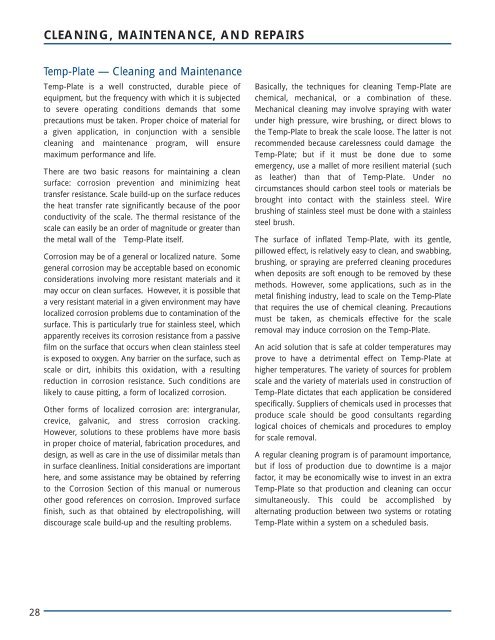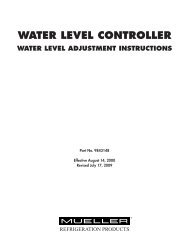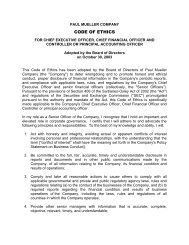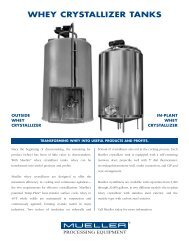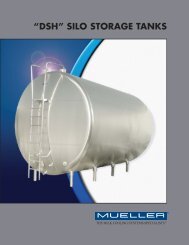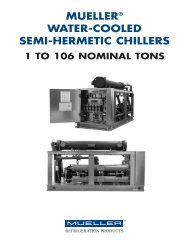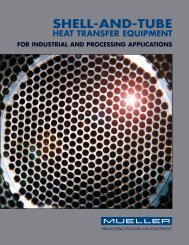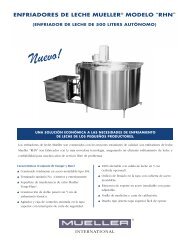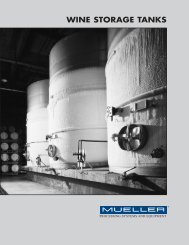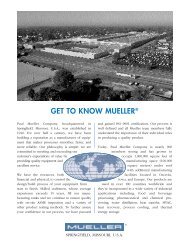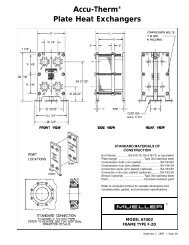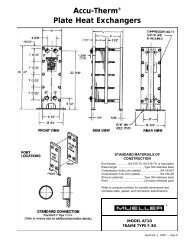ALL ABOUT TEMP-PLATE® - Paul Mueller Company
ALL ABOUT TEMP-PLATE® - Paul Mueller Company
ALL ABOUT TEMP-PLATE® - Paul Mueller Company
You also want an ePaper? Increase the reach of your titles
YUMPU automatically turns print PDFs into web optimized ePapers that Google loves.
28<br />
CLEANING, MAINTENANCE, AND REPAIRS<br />
Temp-Plate — Cleaning and Maintenance<br />
Temp-Plate is a well constructed, durable piece of<br />
equipment, but the frequency with which it is subjected<br />
to severe operating conditions demands that some<br />
precautions must be taken. Proper choice of material for<br />
a given application, in conjunction with a sensible<br />
cleaning and maintenance program, will ensure<br />
maximum performance and life.<br />
There are two basic reasons for maintaining a clean<br />
surface: corrosion prevention and minimizing heat<br />
transfer resistance. Scale build-up on the surface reduces<br />
the heat transfer rate significantly because of the poor<br />
conductivity of the scale. The thermal resistance of the<br />
scale can easily be an order of magnitude or greater than<br />
the metal wall of the Temp-Plate itself.<br />
Corrosion may be of a general or localized nature. Some<br />
general corrosion may be acceptable based on economic<br />
considerations involving more resistant materials and it<br />
may occur on clean surfaces. However, it is possible that<br />
a very resistant material in a given environment may have<br />
localized corrosion problems due to contamination of the<br />
surface. This is particularly true for stainless steel, which<br />
apparently receives its corrosion resistance from a passive<br />
film on the surface that occurs when clean stainless steel<br />
is exposed to oxygen. Any barrier on the surface, such as<br />
scale or dirt, inhibits this oxidation, with a resulting<br />
reduction in corrosion resistance. Such conditions are<br />
likely to cause pitting, a form of localized corrosion.<br />
Other forms of localized corrosion are: intergranular,<br />
crevice, galvanic, and stress corrosion cracking.<br />
However, solutions to these problems have more basis<br />
in proper choice of material, fabrication procedures, and<br />
design, as well as care in the use of dissimilar metals than<br />
in surface cleanliness. Initial considerations are important<br />
here, and some assistance may be obtained by referring<br />
to the Corrosion Section of this manual or numerous<br />
other good references on corrosion. Improved surface<br />
finish, such as that obtained by electropolishing, will<br />
discourage scale build-up and the resulting problems.<br />
Basically, the techniques for cleaning Temp-Plate are<br />
chemical, mechanical, or a combination of these.<br />
Mechanical cleaning may involve spraying with water<br />
under high pressure, wire brushing, or direct blows to<br />
the Temp-Plate to break the scale loose. The latter is not<br />
recommended because carelessness could damage the<br />
Temp-Plate; but if it must be done due to some<br />
emergency, use a mallet of more resilient material (such<br />
as leather) than that of Temp-Plate. Under no<br />
circumstances should carbon steel tools or materials be<br />
brought into contact with the stainless steel. Wire<br />
brushing of stainless steel must be done with a stainless<br />
steel brush.<br />
The surface of inflated Temp-Plate, with its gentle,<br />
pillowed effect, is relatively easy to clean, and swabbing,<br />
brushing, or spraying are preferred cleaning procedures<br />
when deposits are soft enough to be removed by these<br />
methods. However, some applications, such as in the<br />
metal finishing industry, lead to scale on the Temp-Plate<br />
that requires the use of chemical cleaning. Precautions<br />
must be taken, as chemicals effective for the scale<br />
removal may induce corrosion on the Temp-Plate.<br />
An acid solution that is safe at colder temperatures may<br />
prove to have a detrimental effect on Temp-Plate at<br />
higher temperatures. The variety of sources for problem<br />
scale and the variety of materials used in construction of<br />
Temp-Plate dictates that each application be considered<br />
specifically. Suppliers of chemicals used in processes that<br />
produce scale should be good consultants regarding<br />
logical choices of chemicals and procedures to employ<br />
for scale removal.<br />
A regular cleaning program is of paramount importance,<br />
but if loss of production due to downtime is a major<br />
factor, it may be economically wise to invest in an extra<br />
Temp-Plate so that production and cleaning can occur<br />
simultaneously. This could be accomplished by<br />
alternating production between two systems or rotating<br />
Temp-Plate within a system on a scheduled basis.


